Residents urged to take precautions as potential flooding, strong wind grips region
- Read more about Residents urged to take precautions as potential flooding, strong wind grips region
Ratified 09.26.2023 by EPC Members at the Fall Meeting
NAME.
The name of the organization shall be the Emergency Preparedness Council.
BOUNDARIES.
The boundaries of the Emergency Preparedness Council shall be the same as those established by Clackamas County. These boundaries take into account natural boundaries, commercial patterns, community organizations and historic factors.
PURPOSE.
The purpose of the Emergency Preparedness Council is to review and offer advice in all matters relating to emergency management and disaster preparedness. This Council shall submit its observations and recommendations for improvements to the Disaster Management Department and the County Board of Commissioners. During and after an incident, Disaster Management leadership may ask the Emergency Preparedness Council to aid as necessary.
GOALS.
The goals of the Emergency Preparedness Council are as follows:
MEMBERSHIP.
Voting membership shall consist of at least 7 members, with the possibility of no more than nine members, and shall be as representative as possible of the geographic, demographic and philosophical entities of the county. All five members of the Board of County Commissioners will serve as ex officio non voting members. Subject matter experts may be called upon to advise on specific topics as needed. The voting members shall be as follows:
Members of the Emergency Preparedness Council shall be selected from a pool of applicants solicited, received and appointed by the Clackamas County Board of County Commissioners. Membership shall be open to anyone 18 years of age or older who is a resident of the county, a property owner within the county, or a designated representative of a business, non-profit, corporation, or trust within the county.
Membership shall not be limited by race, creed, color, sex, age, heritage, national origin or income.
Members shall have an appointment term of three years which shall expire on June 30. Members may seek reappointment for a maximum of two consecutive terms. Current members seeking a new term on the Emergency Preparedness Council shall submit an application at least 90 days prior to the expiration of their current term.
Vacancies shall be filled through the process established by the Clackamas County Board of Commissioners for Advisory Boards and Commissions.
Three or more consecutive unexcused absences from regularly scheduled Council meetings will be grounds for removal of any Council member. Irregular attendance, failure to accept adequate functional membership responsibility, or consistently counterproductive behavior toward specified goals of the Council may also be considered as a basis for release from membership on the Council.
Before any member is considered for release for any reason, they will be given the opportunity to present their appeal for retention. The Board of County Commissioners and the Emergency Preparedness Council officers , working with the staff liaison, will decide whether to retain a member.
OFFICERS.
The officers of the Emergency Preparedness Council shall include the following:
The Emergency Preparedness Council shall provide the County Public and Government Affairs Department with a current list of officers.
SELECTION OF OFFICERS.
The election of officers shall be held annually at the last regular meeting of the fiscal year. For the initial year, all officers are elected by majority of voting members. Annual elections shall be for the Vice-Chairperson. The current Vice-Chairperson will be the Chairperson-elect for the next year. The current chair shall announce the matter of the upcoming election no later than at the penultimate meeting of the fiscal year. Nominations for the offices may be made at that time through the elective meeting. If no person receives a majority vote for election on the first ballot, the two receiving the highest number of votes will be considered on a second ballot.
Members shall assume their duties at the beginning of the fiscal year, except for those elected to vacant positions, who should assume their duties immediately upon election. All voting members are eligible for election to officer positions. The Chairperson shall not vote for an officer except in the event of a tie when the Chairperson shall cast the deciding vote. Proxy votes shall not be allowed.
TERM OF OFFICE.
The term of office for all officers shall be one year, however, the officer is requested to continue to serve until a successor is elected or appointed to that office.
VACANCIES.
A vacancy occurs when an officer dies, resigns, is removed, is no longer eligible to serve, or has more than three unexcused absences from meetings during a calendar year. A vacancy shall be filled by appointment by the Board of County Commissioners. The person appointed to fill the vacancy shall serve the remainder of the unexpired term and until a successor is elected or appointed to that office.
MEETINGS.
Meetings of the Emergency Preparedness Council shall be held in accordance with the
Oregon Public Meetings Laws. Meetings shall be held no less than twice per year, usually in the Central Utility Plant in Oregon City, at a time and place designated by the chair of the Council. County staff shall ensure that appropriate notice is provided to all interested persons and agencies.
The Chairperson may call special meetings as deemed necessary.
Notice of all meetings shall be provided as required by ORS 192.640 of the Oregon Public Meetings Law.
Minutes of all meetings shall be kept and shall be available for public inspection as required by ORS 192.650 of the Oregon Public Meetings Law. A copy of all meeting agendas and minutes shall be provided to the County Public and Government Relations Office.
QUORUM and VOTING.
A quorum shall be present at a meeting in order for the Council to transact business. A quorum of the membership shall consist of a majority of the voting membership. Members must be present, either in-person or virtually, to form a quorum and conduct official business. A vacancy on the board does not affect the quorum requirements. A simple majority of the Council members present shall provide the deciding vote on any subject brought before the Council. The chair or presiding officer shall only vote in the case of a tie vote.
Any member who anticipates in advance an absence from a regularly scheduled Council meeting should report that possibility to the staff liaison of the Council and the Council officers.
RECORDS.
All records of the Emergency Preparedness Council shall be subject to disclosure except as allowed by exemptions of the Oregon Public Records Law.
HEARING PROCESS AND PROCEDURE.
Robert's Rules of Order shall govern proceedings at any meeting of the Emergency Preparedness Council. The Chair shall be guided by these principles in deciding any procedural questions. The Chair's decision on procedural matters may be overruled by a majority of the members voting on the question.
MEETING CONDUCT.
The rules contained in the most current edition of Robert's Rules of Order Newly Revised shall govern the Council in all matters in which they are applicable and in which they are not inconsistent with these Bylaws and any special rules of order the Council may adopt. The chair of the Council shall establish the agenda with the assistance of the vice-chair and staff liaison. The Council shall attempt to complete all agenda business at each meeting. If the time for conducting required business exceeds a reasonable hour, the chair or any member may propose a carry-over of remaining business to a special meeting date to be designated, or to the next regularly scheduled meeting.
MEETING MINUTES.
Minutes of each meeting shall record the presence and absence of each member.
They shall also document the business conducted at the meeting and a summary of the discussions and recorded decisions including proposed motions, seconds to the motion and discussions, dissentions, and abstentions. Completed minutes shall be electronically conveyed to members prior to the next meeting.
County staff will support the drafting of the meeting minutes.
COUNTY DEPARTMENT PARTICIPATION.
The Council will be aided in the conduct of its functions by
designated County staff or their representatives. These designated representatives will be ex-officio members of the Council and will be nonvoting. They will be designated by the Disaster Management
Director or his/her designee. The Chair of the Council may request additional appointees to be designated representatives if it appears there is a need. These representatives will provide the Council with consulting services and assistance in their respective technical areas.
NON-COUNTY GOVERNMENTAL PARTICIPATION.
Representatives from other governmental agencies
may be asked by the Council to participate on a case-by-case basis if their input can assist the Council.
These representatives will not become members of the Council.
Other governmental and non-governmental agencies and representatives may also be asked to provide input for specific subject matter expertise, on an as needed basis.
SUB-COMMITTEES.
The Emergency Preparedness Council may create and modify subcommittees as required to promote the purposes and objectives of the Council. A chairperson for each sub-committee shall be selected by the Chair. Subcommittee participation may include non-Council members, particularly to provide subject matter expertise beyond a single meeting. Requests should be made in coordination with the Council Chair and Disaster Management staff. Subcommittees should be considered ad hoc, with terms to be determined by the Council. In order to maintain a focus and a manageable workload, the Council should review the need for any serving subcommittees at least every six months.
DISSOLUTION.
The Emergency Preparedness Council shall be considered inactive if it fails to meet the requirements of these bylaws. An inactive Council shall be dissolved and will no longer be recognized by the Board of County Commissioners.
AMENDMENTS.
Any member on any appropriate subject may propose bylaw modifications. Such proposals will be submitted in writing to the chair of the Council. The submitted proposals shall be read during the meeting at which they are first presented. Discussion of the proposals will be limited to clarification of intent and verbiage at that meeting.
The staff liaison shall ensure that the proposal, as modified by the limited discussion in the meeting, be forwarded to each Council member, the County Public and Government Affairs Department, and County Counsel, along with a copy of the recorded minutes of the meeting. The proposed bylaw modifications shall be voted on at the next official meeting of the Council. If a majority of the quorum present approves the proposal, and no objection is received from County Counsel, the proposed changes shall be incorporated into the Bylaws.
The amended bylaws shall supersede all previous bylaws and become the governing rules for the Emergency Preparedness Council.
POLICIES.
The Council shall adopt and follow the general operating policies recommended by the Board of County Commissioners. Primary among these policies and key guidelines to the Council are the following:
AUTHORITY TO BIND.
The Clackamas County Emergency Preparedness Council, its members individually or collectively cannot commit Clackamas County, its officers or agents to financial obligation unless approved beforehand in writing for the express amount and purpose. Such approval must have the funding account and citation number approved.
There are serious risks that rising water poses to both household pets and livestock.
For livestock that need to be transported due to flooding, owners can transport their livestock to the Clackamas County Fairgrounds. Enter through the red gate.
Floodwaters can contain dangerous debris, sharp objects, contaminants, and fast-moving currents that place animals at high risk for injury, drowning, or exposure to harmful bacteria and chemicals. Even a few inches of moving water can sweep animals off their feet, and standing water can hide hazards such as downed fencing, holes, and displaced wildlife.
If you live in an affected area:
For livestock:
Preparing a basic evacuation plan for both pets and livestock can make a critical difference during emergencies. Keep carriers, halters, identification, and a supply of food and medications readily accessible. Staying proactive and aware helps protect the animals who depend on us most.
Stay Grounded This Fall!
Fall Greetings from the Clackamas County Disaster Management Team. In light of Earthquake Preparedness Month in October, this newsletter will include:
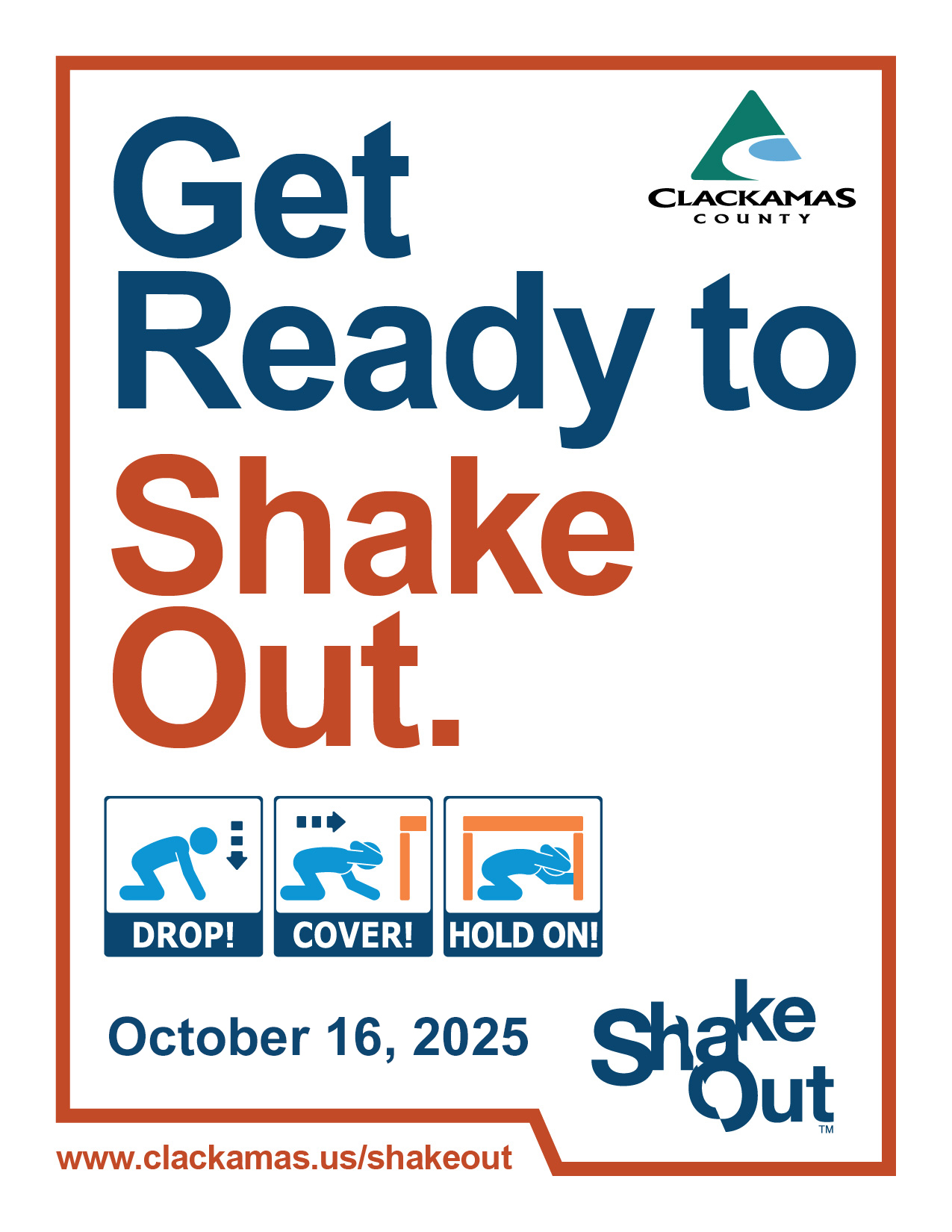
The Great ShakeOut is an annual event where all community members have an opportunity to practice Drop, Cover, Hold On, as a response to an earthquake event. This annual drill also provides an opportunity for individuals to create and review family emergency plans, look for opportunities to mitigate damage to their homes or workplace areas, and reflect on how they might respond to an earthquake once the ground starts to shake. Here at Clackamas County, staff participated in the ShakeOut on October 16, through a selfie contest, home hazard hunt survey, and a COOP call down exercise. Disaster Management Staff also prepared a presentation to our Board of County Commissioners detailing the importance of the ShakeOut drill, the threat of earthquakes in our region, and the need for all community members to take steps to prepare for emergencies by making a family plan, preparing an emergency kit, and even signing up for emergency alerts.
Disaster Management hosted a ShakeOut Selfie contest to encourage participation in the ShakeOut and promote earthquake preparedness. Thirty-four ShakeOut selfies were submitted with options for County staff to vote on which they liked the most. Check out some of our selfies!
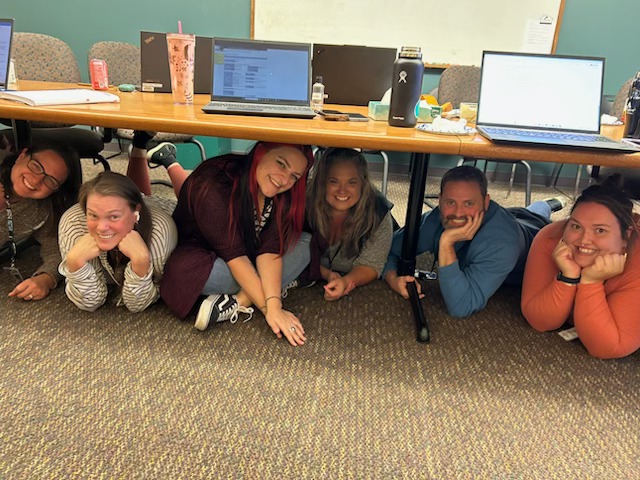
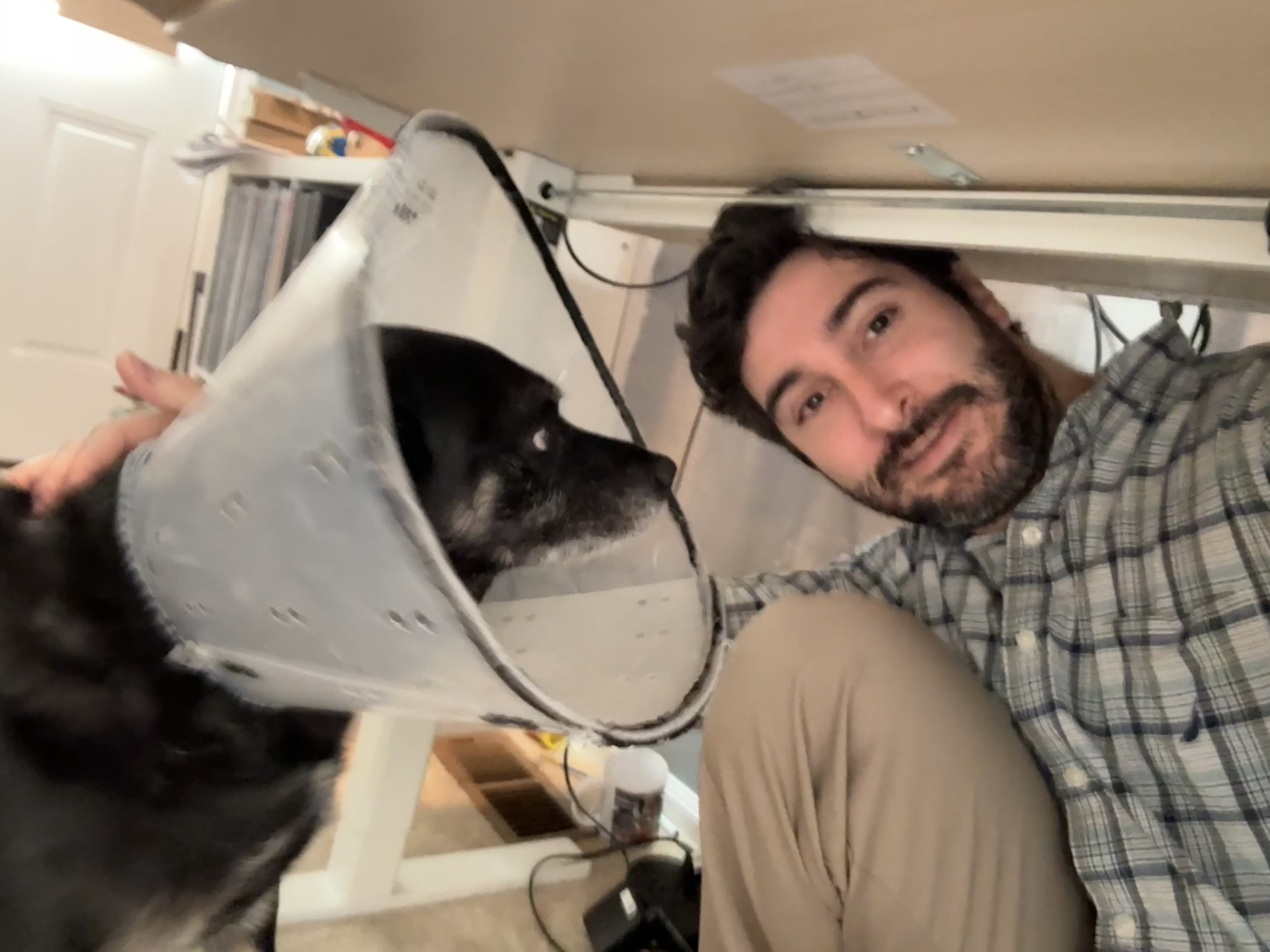
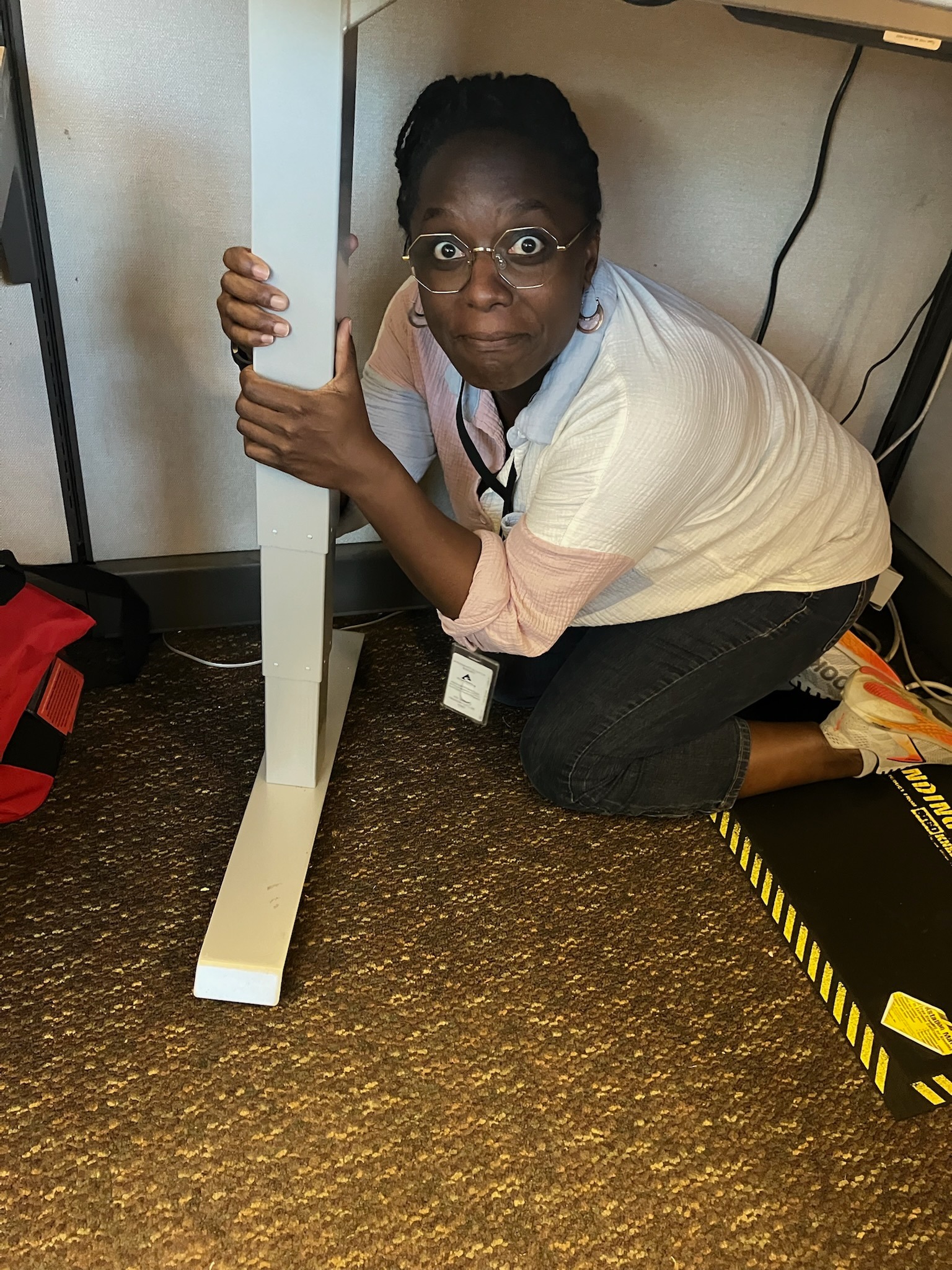
The Home Hazard Hunt contest is designed for folks to look around their home and identify possible hazards during an earthquake and any methods for mitigating those hazards such as moving heavy objects to lower shelves or securing furniture to prevent movement. Fifty-eight County staff submitted a survey; identifying at least one thing in their home that could be secured and one thing that they can do to better prepare their home for an earthquake. Find more information on securing your space.
In addition to identifying hazards, staff were also asked a bonus question of their favorite music video from our County Earthquake playlist, and Taylor Swift’s, “Shake It Off” took first place followed by the Beatles’ “Twist and Shout.”
Disaster Management hosted a COOP Call Down Exercise immediately following the ShakeOut drill to allow County Departments an opportunity to validate their COOP plan and emergency notification procedures. The exercise entailed use of a call down, which is a systematic series of telephone calls, texts, or email messages from one person to another to relay emergency information and/or activate their COOP plan. Practicing this call down provided an opportunity for staff to rehearse their plan and account for staff following a disruptive event. It also allowed us to identify gaps or areas of improvement regarding emergency notifications to fellow staff.
Businesses can learn more about continuity planning.
The annual Great ShakeOut is a nationally recognized earthquake safety drill that builds on required school earthquake drills. Drop, Cover, and Hold On is practiced universally for the best all-around approach to take immediate protective measures at the onset of earthquake shaking.
Drop to the floor to lower your center of gravity. Cover as much of your body, especially your head and neck, under or beside strong furniture like a table or desk. Hold on to the furniture or something close by to stabilize yourself during the shaking.
Taking this immediate action helps avoid indoor injuries from falling non-structural elements like bookcases, light fixtures, and suspended ceiling tiles from shaking that can quickly escalate and last for seconds to minutes. Strong shaking can also increase the likelihood of falling injuries if people are trying to move or relocate.
Going outside of a building during an earthquake may seem like an intuitive response, but there are lots of potential falling hazards from buildings like parapets, chimneys, broken windows and building facades, that can be more dangerous than indoor falling hazards.
Even with the advent of the earthquake alert system called ShakeAlert, which is designed to detect and notify populations of impending shaking, there are too many variables between different earthquake sources in the Clackamas County area to safely recommend evacuating a building with 10 seconds of notice - especially a multi-story building like a school. Moving through and then outside of a building at the onset of strong shaking can greatly increase your chances of injury or death.
Instead, if a ShakeAlert announcement occurs, consider it an extra moment to assess your immediate situation and make an informed safety decision. Perhaps move away from a window or outside wall or give yourself some extra space away from a loaded bookshelf. Then, drop, cover, and hold on.
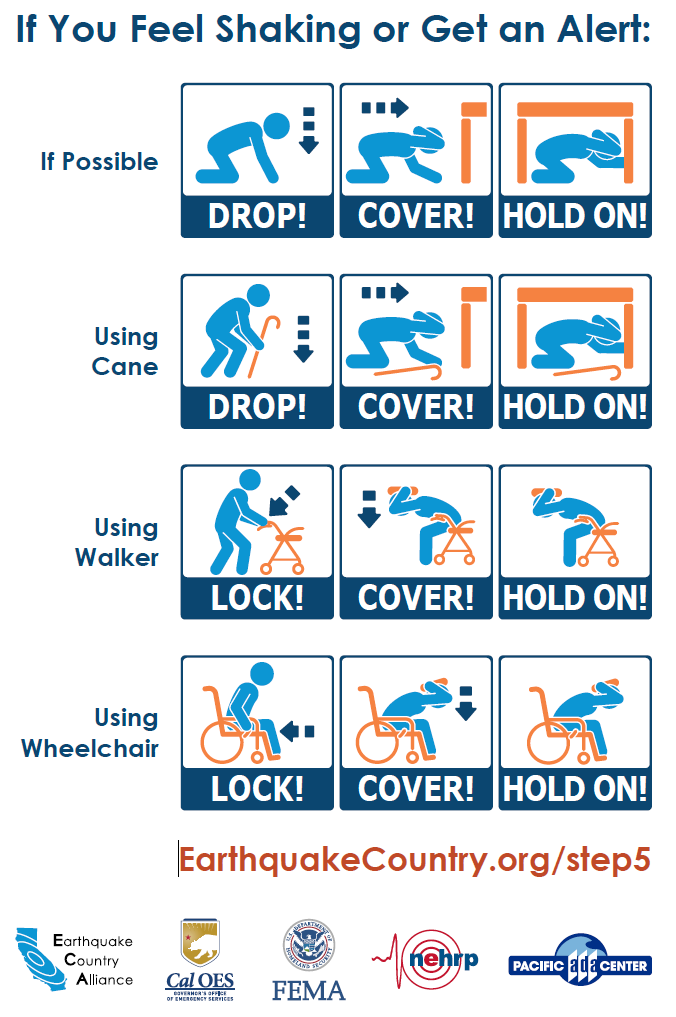
Please contact Carolyn Bonoff at cbonoff@clackamas.us.
After recent disasters, Clackamas County conducted evacuation planning that considers the impact of multiple hazards on the community’s transportation networks.
This Evacuation Planning work has been taking place since 2023, in 3 phases:
The first phase of the project, conducted in 2023, developed a GIS-based Risk Inventory and identified potential evacuation zones and routes. The Risk Inventory considered roadway data, land use, hazard data, demographic information, natural features, and key community uses. Preliminary zones and routes were created at the conclusion of this phase.
The second phase of the project sought engagement from local partners to validate and refine the evacuation zones and routes, and to inform strategies for introducing the zones and routes to the general public. It included work sessions with local public agencies and community partners. Clackamas County engaged key partners to ensure local jurisdictions and subject-matter experts were included in the review process. This created a shared understanding between local, regional, and state agencies. It also ensures that evacuation protocols across jurisdictional boundaries are considered. In February of 2024 evacuation planning maps and routes were finalized.
The third phase of this project occurred during Winter- Summer 2025, and was focused on gathering community feedback about evacuation preparedness to then inform the public education campaign. The county sought feedback from residents through a public survey, focus groups in rural communities, and 1:1 interviews with community leaders; all conducted in both English and Spanish. The county learned residents’ preferred communication channels to share information during incidents, and identified resource gaps about preparedness for potential evacuations. All this work has culminated in a public evacuation preparedness campaign — Be ClackGO Prepared — which launched in May 2025.
Clackamas County Disaster Management
Newsletter July 2025
We are now launching a quarterly newsletter, with June as our first issue!
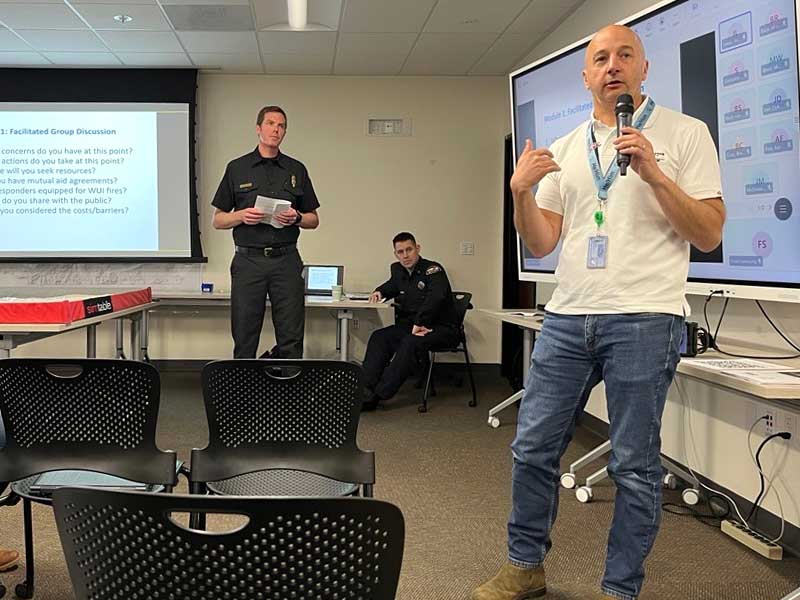
Last year Oregon saw a record-breaking wildfire season. This year we have already seen a fire significantly impact the Rowena community and it's just the beginning of a forecasted bad wildfire season. Every fire season can certainly increase anxiety and bring up memories from the 2020 wildfire season.
While I certainly feel uneasy as the season starts, I'm also optimistic and hopeful. Every year Clackamas County and its partners continue to strengthen their response capabilities. The wildfire exercise series and ClackGo preparedness messaging included here are just two examples. It also includes increasing our partnership with the Clackamas Voluntary Organizations Active in Disasters (VOAD) and the Clackamas Amateur Radio Emergency Services (CARES). In addition, Disaster Management was able to use grant funding to partner with Clackamas Fire to support fuels reduction and staff support for the Clackamas Wildfire Partnership. The County has also invested in increasing the collaboration and communication tools of the Emergency Operations Center.
Even as the county is entering this fire season, we are already scoping planning projects to prepare for next year's fire season. These include: another exercise series, further documenting and implementing our evacuation planning to include animal and livestock evacuation, and adding to the ClackGo Prepared materials and website, all while building relationships with current partners and finding new ones.
Every fire season can cause some anxiety and require vigilance, but I hope you can feel a little optimism this year in the preparations the county and its partners have taken. I also invite you to join us in the preparation by going to clackgoprepared.org and either starting or continuing your preparedness journey.
If you are interested in learning more about this year's or next year's preparedness, please reach out to Disaster Management at CCDM@clackamas.us.
- Daniel Nibouar
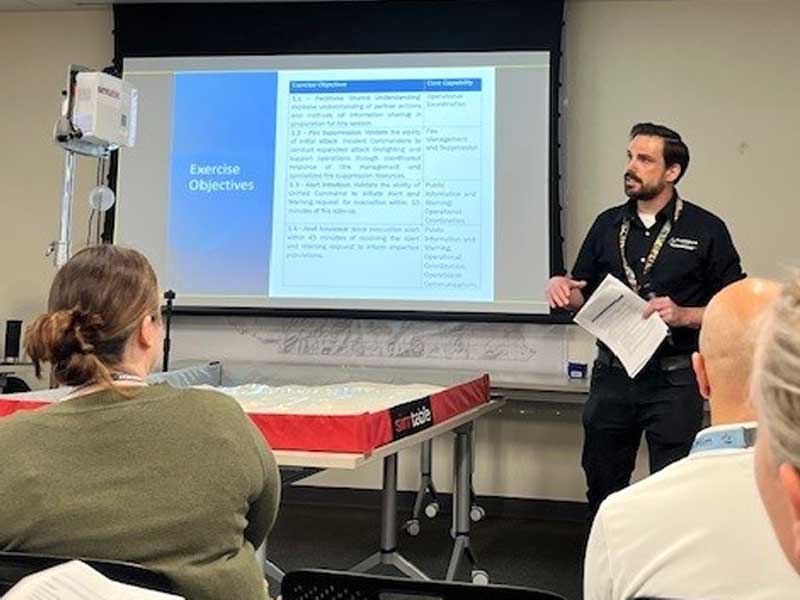
Clackamas County Hosts Wildfire Evacuation Exercise Series with Local and Regional Partners
As wildfire season approaches, Clackamas County and its regional partners took coordinated steps to strengthen community readiness. Through a three-day Wildfire Evacuation Exercise Series held this spring, more than 40 departments and agencies across local, state, and federal levels came together to rehearse, evaluate, and enhance their wildfire evacuation response capabilities.
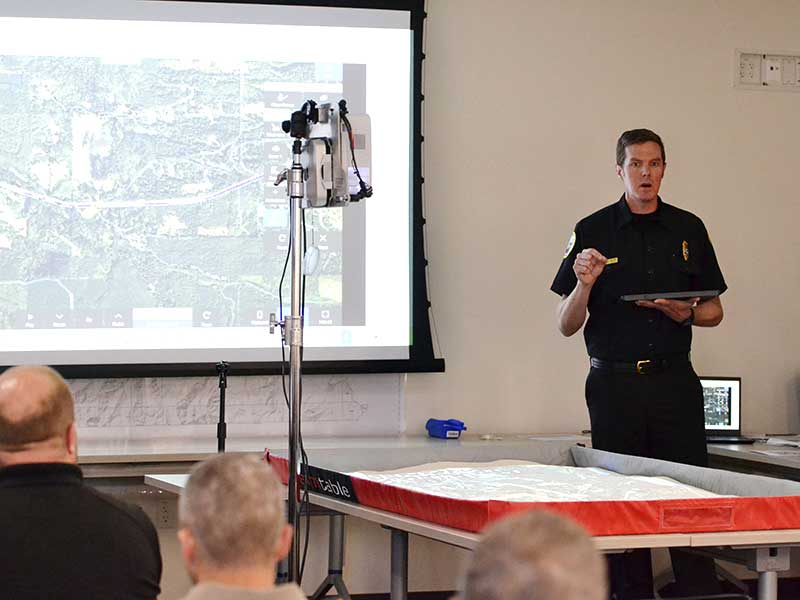 This exercise series brought together a diverse mix of responders and support agencies—from fire districts and emergency managers to utility companies, law enforcement, and communications teams. Participating organizations included Clackamas Fire, the Clackamas County Sheriff's Office, National Weather Service, Portland General Electric, Oregon Department of Forestry, and many other critical partners.
This exercise series brought together a diverse mix of responders and support agencies—from fire districts and emergency managers to utility companies, law enforcement, and communications teams. Participating organizations included Clackamas Fire, the Clackamas County Sheriff's Office, National Weather Service, Portland General Electric, Oregon Department of Forestry, and many other critical partners.
The series not only examined operational coordination but also strengthened the relationships and shared understanding that form the backbone of regional disaster response. Through scenario-based collaboration, Clackamas County and its partners advanced their preparedness posture and reaffirmed their commitment to protecting lives, property, and natural resources during fire season.
Recent disasters have highlighted the need for predefined evacuation zones to be used in emergencies to quickly delineate and communicate evacuation levels, avoiding the need to define new evacuation level boundaries in reaction to an emergency. To respond to this need, the county has identified and refined evacuation zones and routes as part of an all-hazard approach to evacuation planning.
Clackamas County Disaster Management is in the third and final phase of Evacuation Planning, focused on community engagement and a public communication campaign. This portion of the project aims to gather information about how Clackamas County residents are seeking information, the best ways to share time-sensitive information with them, and attitudes toward disaster preparedness.
Clackamas County Disaster Management will share this evacuation preparedness information with the public as part of a campaign beginning May 27th.
Be ClackGO Prepared! Our community is stronger when we prepare together.
We will be giving away check lists, stickers, first aid kits, flashlights, headlamps, and other ClackGO kit materials to help get people started at local community events.
We will be asking the public to share photos of themselves on social with the #ClackGOKit, to be entered into a drawing to win more expensive items to add to their go kit.
Questions? Suggestions?
Please contact Carolyn Bonoff at cbonoff@clackamas.us.
Our community is stronger when we prepare for emergencies together. Take these steps now to help get your family ready and be ClackGO Prepared!
Follow us on Facebook and Instagram to see our messages (in English and Spanish).